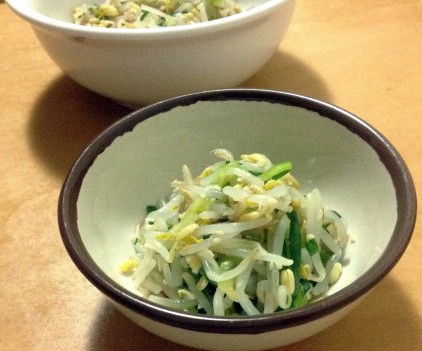

People regarded Sin Sukju's move as unethical and immoral, and so gave his name to mung bean sprouts, which tend to go bad and spoil very easily. Sin Sukju betrayed his colleagues and favoured the King's uncle as a claimant to the throne. The name sukjunamul is a compound of Sukju and namul, of which the former derived from the name of Sin Sukju (1417–1475), one of the prominent Joseon scholars. Mung bean sprouts are not as common an ingredient as soybean sprouts in Korean cuisine, but they are used in bibimbap, in the fillings of dumplings and in sundae (Korean sausage). In Korean cuisine, sukjunamul (숙주나물) refers to both the mung bean sprouts themselves and the namul (seasoned vegetable dish) made from mung bean sprouts. The main principles are: selecting good seed (new and uniform), ensuring that light reaches the seeds, and also ensuring they receive enough humidity while avoiding waterlogging. The precise growing technique to use depends on the amount that one wants to collect. Fresh water is then poured into the jar three to four times a day the jars are then upturned and left to drain. A common technique for home growers is sprouting the beans in a jar, with a fine mesh or muslin cloth tied over the top with a rubber band or string. Mung bean sprouts are extensively cultivated and consumed in East and Southeast Asia.Ī variety of techniques are used for sprouting mung beans. They can be grown by placing and watering the sprouted beans in the shade until the hypocotyls grow long. Mung bean sprouts are a culinary vegetable grown by sprouting mung beans.
#Bean sprout korean side dish full#
It's full of umami flavor and goes great with any Asian meal. Today, I will be providing you a great Asian recipe for an Authentic Korean Bean Sprout Kimchi Side Dish (Sukjunamul-muchim: 숙주나물무침). Ed.Have you ever made a meal, but felt that you could use just one more side dish? Me too.

She shares her recipes and food memories in her blog, Beyond Kimchee. Hye-gyoung Ford (aka Holly) is a well-known Korean food blogger and the author of “Korean Cooking Favorites.” Born and raised in Korea, she has lived in many countries. Taste the salad and add more salt if needed. Toss the salad with your hand or using kitchen tongs to mix well.ĥ. Add garlic, green onion, Korean soy sauce, sesame oil, toasted sesame seeds, and a pinch of salt. Place the warm sprouts in a large mixing bowl. Drain the spouts in a colander to remove the extra water and let cool for a couple of minutes.Ĥ. Stir and turn the sprouts so that the ones on the bottom come to the top and the ones on the top end up on the bottom, and wait for 30 seconds.ģ. Remove the pot from the heat and open the lid. If you have a glass lid, you will see the steamed water drips down under the lid.Ģ. Close the lid tightly and let the sprouts cook over medium heat for 6 minutes. Put sprouts in a pot and pour in 4 tablespoons of water. 2 tsp Korean soup soy sauce (gukganjang)ġ. Korean people never get tired of making this delicious side dish with soybean sprouts. Whether you grow your own sprouts or buy them at the store, they are inexpensive. Some people grow their own soybean sprouts at home so that they can eat the sprouts anytime they want. For that reason, Koreans call it a “national side dish of Korea (gukmin banchan)” because every household consumes this bean sprout Korean side dish at least once a week. It is perhaps the most common Korean side dish of all.

We call this soybean sprout side dish, kongnamul muchim in Korean. This salad side dish recipe is easy to make and is one of the many healthy banchan, Korean side dishes, that can accompany any Korean or Asian meal. It has a crunchy texture and nutty taste. This Korean bean sprout side dish is made with soybean sprouts.


 0 kommentar(er)
0 kommentar(er)
